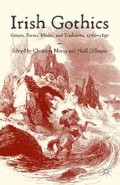Abstract
Masculinity, despite its reputation, is rather a fragile attribute. It is extraordinarily vulnerable to all manner of attack and quite easy to undermine. A given man’s grasp of it at any stage of life is precari- ous to say the least, and most men appear to feel a constant need to assert, defend, apply, and uphold it. As the great historian of masculin- ity Michael Kimmel puts it, from the start of the nineteenth century at least, men have expended a great deal of energy in a ‘relentless effort to prove their masculinity’, however that masculinity was defined: ‘men have been afraid of not measuring up to some vaguely defined notions of what it means to be a man, afraid of failure’.1 Fear rather than (or at least, as well as) power has stalked the quest for masculinity, and when fears need to be addressed, the Gothic genre has long been useful as a means by which the cultural and existential battle could be fought. The Gothic genre has been concerned with masculinity since its inception. Horace Walpole’s The Castle ofOtranto (1764) begins with an enormous helmet crushing delicate, weakly Conrad, a poor excuse for a man, as if to warn against alternatives to hegemonic masculinity, and ends with Alphonso the Great assuming gigantic size and asserting the metaphys- ical power of primogeniture and normativity. Although much critical attention has rightly been paid to what Barbara Creed famously called the ‘monstrous-feminine’,2 the way femininity and femaleness has been consistently monstered in modernity, the heroes of the Gothic genre are as likely to be in battle with a degraded and dangerous version of mas- culinity as they are with a she-beast.
Access this chapter
Tax calculation will be finalised at checkout
Purchases are for personal use only
Preview
Unable to display preview. Download preview PDF.
Notes
Michael Kimmel (2012) Manhood in America: a Cultural History (Oxford: Oxford University Press), p. 15.
Barbara Creed (1993) The Monstrous-Feminine: Film, Feminism, Psychoanalysis (London: Routledge).
Bram Stoker (1905) The Man (London: William Heinemann), pp. 3–4.
Horace Träubel (1953) With Walt Whitman in Camden: 21 January — 7 April 1889, ed. Sculley Bradley (London: Oxford University Press), pp. 181–5.
L. Perry Curtis, Jr (1971) Apes and Angels: the Irishman in Victorian Caricature (Washington, DC: Smithsonian Institution Press).
Joseph Valente (2011) The Myth of Manliness in Irish National Culture, 1880–1922 (Urbana, IL: University of Illinois Press), p. 11.
Rosalind Miles (1991) The Rites of Man: Love, Sex and Death in the Making of the Male (London: Grafton Books), p. 111.
David Glover (1996) Vampires, Mummies, and Liberals (Durham, NC: Duke University Press), p. 49.
William Hughes (2000) Beyond Dracula: Bram Stoker’s Fiction and its Cultural Context (London: Macmillan), p. 63.
Joe Lee (2008) The Modernisation of Irish Society, 1848–1918 (Dublin: Gill and Macmillan).
W. B. Yeats (1955) Autobiographies (Dublin: Gill and Macmillan), p. 559.
Editor information
Editors and Affiliations
Copyright information
© 2014 Jarlath Killeen
About this chapter
Cite this chapter
Killeen, J. (2014). Muscling Up: Bram Stoker and Irish Masculinity in The Snake’s Pass. In: Morin, C., Gillespie, N. (eds) Irish Gothics. Palgrave Macmillan, London. https://doi.org/10.1057/9781137366658_10
Download citation
DOI: https://doi.org/10.1057/9781137366658_10
Publisher Name: Palgrave Macmillan, London
Print ISBN: 978-1-349-47423-3
Online ISBN: 978-1-137-36665-8
eBook Packages: Palgrave Literature CollectionLiterature, Cultural and Media Studies (R0)

